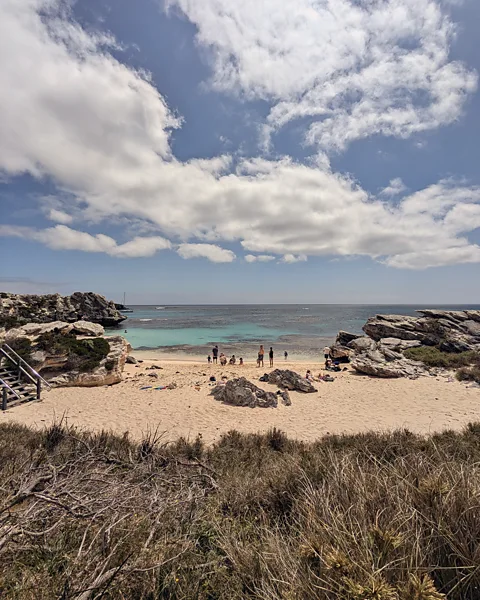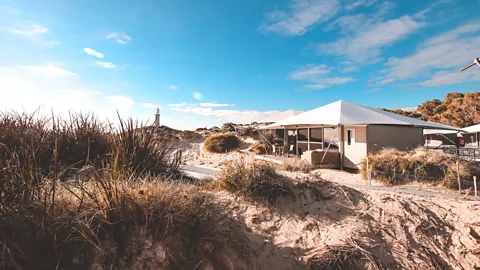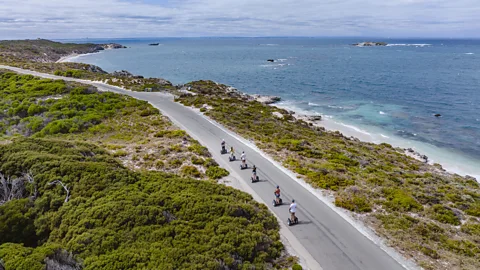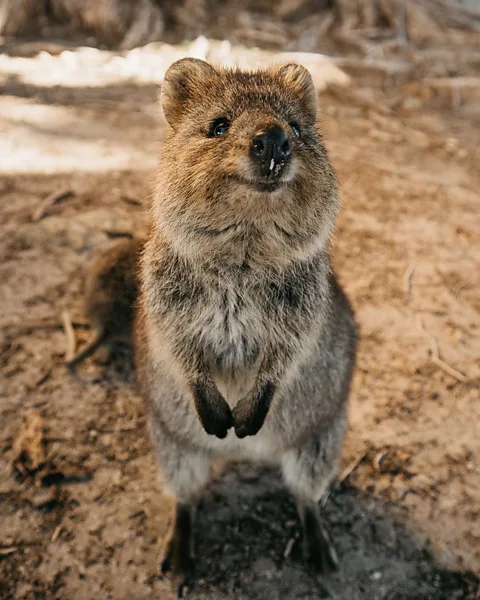The Indian Ocean's laid-back 'paradise on Earth'
 Tourism Western Australia
Tourism Western AustraliaFamous for its adorable quokkas, Rottnest Island has become a global favourite. But beyond the selfies lies a rich, complex story of culture, conservation and community.
On a recent visit to Perth, I mentioned to a local that I was heading to Rottnest Island the next day. She sighed wistfully. "I love it there," she said. "You're going to love it too. It has a special kind of magic – the kind of place where you kick off your shoes the minute you arrive. Everything slows down and you can breathe a little more deeply."
I already felt that Perth was a little like that – at least, life there felt slower and less frenzied than in my hometown of Melbourne on Australia's east coast – but I smiled back, not really knowing what she meant.
However, she was right. Rottnest Island, a peaceful 19-sq-km isle off the coast of Western Australia, is, in fact, magical. The spell was cast as soon as our ferry left the mainland, skimming over the Indian Ocean. Humpback whales breached nearby, sending jets of sea spray into the air and flipping their tails as if in welcome. The sky was clear with the promise of a perfect day to come.
Just 19km and 30 minutes later, I stepped off the ferry into another world. Rottnest Island has been famously car-free since 1931, and those more in the know than me immediately jumped onto bikes they'd brought with them or wandered off to hire one from Pedal and Flipper, said to be the largest bike hire place in the southern hemisphere.
 Ellie Cobb
Ellie CobbKids zoomed around in packs, dodging groups of tourists ambling through the main settlement. Some people had fishing rods under one arm; others, surfboards strapped to their bikes. Families stopped at the bakery for a flat white and vanilla slice before heading off to explore the island's 63 beaches and 20 bays, many with evocative names like Little Parakeet Bay and Cathedral Rocks that in no way came close to capturing the grandeur of the scenery in real life.
Green Getaways
Green Getaways is a BBC Travel series that helps travellers experience a greener, cleaner approach to getting out and seeing the world.
There was no urban noise, no traffic and nothing to worry about. It was idyllic and glorious and everything I imagined a nostalgic care-free (and car-free) island holiday to be.
The isle has long been a cherished playground for generations of Western Australian families.
"Rottnest is very, very special, particularly to the people of Perth, like me," explained Paul Campbell, a volunteer guide I met not long after I arrived. Campbell spent his childhood holidays on Rottnest and now returns regularly to tell people about his beloved island. "There are no multi-storey high-rise hotels here," he added. "There is no private ownership. If you ever tried to put a multi-storey-anything here for wealthy people, you would be absolutely torn to shreds. We are very protective of our beautiful island."
Once a well-kept secret from the rest of the world, in recent years Rottnest has become one of Australia's most Instagrammed destinations, thanks to a certain fuzzy-faced resident: the quokka.
 Tourism Western Australia
Tourism Western AustraliaIn 2013, Huffington Post dubbed the quokka "the happiest animal in the world", and the internet responded in glee. Quokkas – tiny marsupials found only in this small pocket of south-western Australia – seem to smile for selfies in a way that feels almost staged. Tennis star Roger Federer to actress Margot Robbie were among the first celebrities to pose with the infamous animal, helping spark a wave of global attention. Then in 2019 came Chris Hemsworth's now-iconic #QuokkaSelfie with Matt Damon, which racked up more than four million likes. "Rotto", as locals call it, became the hottest ticket in town, transforming from local secret to global sensation. According to the Rottnest Island Authority, annual visitor numbers have nearly tripled in the last decade, peaking at more than 800,000 at last count.
What's in a name?
The island was first sighted by Dutch explorers in the 17th Century and was named by one such captain, Wallem de Vlamingh, who stayed on the island for six days and mistook the quokkas for rats. He referred the island as "'t elyandt 't rottenest" which means "rat's nest island" in Dutch – although by all accounts he was also captivated by the pristine scenery and referred to it as "paradise on Earth" in his journal.
Rottnest, once simple and sleepy, has had to quickly grow up to meet the demands of all these domestic and international tourists. That meant creating more accommodation than the basic cabins and camping that existed, as well as better food and activity options. And what it has done is exemplary, transforming into a model of eco-conscious tourism without losing its soul.
As Campbell put it: "When I was nine years old, the [cultural] experience that I had on Rottnest is not that much different to what you're going to experience today."
You won't find any private cars here – just a few vehicles for rangers and staff – so most everyone gets about on two wheels or two feet (or the odd skateboard, scooter or Segway), having to occasionally dodge quokkas lounging on the road. Accommodation ranges from beachside cottages with bike racks out front to backpacker dorms to relaxed boutique hotels. While many tourists come on a day trip from Perth, it's much better to stay the night: quokkas are nocturnal and will spend most of the day sleeping under shady bushes. In addition, most day-trippers leave by 16:30, at which point the island truly comes into its own.
 Discovery Resorts
Discovery Resorts"Someone once said to me that you can feel the island exhale [when they leave]," said Erin Gallagher from the Rottnest Island Authority. "I just thought it was the most beautiful thing – and it's so true."
I was staying at Discovery Resorts, the island's first eco resort, whose 83 glamping tents are shaded by gum trees and Aleppo pines, tucked behind Pinky Beach in the sand dunes. My tent had no aircon or TV, just a ceiling fan for airflow and the sound of the ocean through canvas walls. It was perfect in its simplicity. "[The resort] is designed to immerse guests into the environment," explained Krizza Miclat, the resort's sales and event manager. "A lot of the infrastructure is elevated on steel poles to ensure that we're not damaging the sand dunes. So, if ever we were to pick up and move, we haven't impacted it too much."
In fact, nearly everything here works in harmony with the natural environment. Renewable energy is provided by the Indian Ocean's sea breezes and the strong Western Australian sun; while drinking water is drawn from the sweeping white semi-circle of Longreach Bay, desalinated and filtered. Marine sanctuary zones below water mean world-class snorkelling and diving, and an island nursery grows native plants from locally sourced cuttings and seeds. In 2023, a new management plan reaffirmed Rottnest's commitment to sustainability, conservation and culture.
"We're always striving to improve," said Gallagher. "Our target is to achieve 75% renewables. There's even an app where anyone can see how much power the island is generating in real time."
More like this:
• A day out with Bluey: Australia's new experience brings the Heeler family to life
In the spirit of low-impact activities, I decided to take a Segway tour around the undulating landscape, rolling along the endless beaches, gliding past the cluster of salt lakes in the north-eastern corner and looking out for whales on the island's Humpback Highway. I steered past the scrub heath that covers much of the island, breathing in its signature salty-sweet smell and dodging prickle lily and feather speargrass. The island is just 11km long and 4.5km at its widest point, but its biodiversity is vast – a Class A reserve where everything from the blue-flowered Rottnest daisy to the long, black king skink I saw on the side of a trail is protected.
 Tourism Western Australia
Tourism Western AustraliaBut not all scenes here are so idyllic.
In 1838, Rottnest was turned into an Aboriginal prison. Over the next century, more than 4,000 Indigenous men and boys were incarcerated here for "crimes" that they often didn't know they'd committed. Some were as young as eight years old. Many never returned home.
Plan your trip:
Get there: Regular ferries are operated by Sealink and Rottnest Express (leaving from Perth CBD and Fremantle) and Rottnest Fast Ferries (leaving from Hillarys Boat Harbour, north of Perth CBD)
When to go: Summer (December-February) is the most popular (and crowded) time, but September-April is still warm enough for water-based activities. If you want to celebrate quokka joeys taking their first hops, visit 21-22 September 2025 for
Little Quokka’s Big Birthday Weekend
.
Where to stay:
Book an eco-glamping tent at
or stay at the newly opened
.
Eat:
for pizzas and salads; Sunset snacks and drinks at
;
for craydogs (a spicy crayfish-stuffed roll);
for more upmarket fare.
Do:
Hire a bike, snorkel and mask from Pedal and Flipper to explore the island at your own pace. Head to Garden Lake at sunset for epic quokka sightings. Take a guided
Segway tour to learn about the island's history as you explore.
It's a dark legacy that the island is only beginning to address. As I wobbled my Segway back to the main settlement, we passed what looked like an ordinary field. But, my tour guide explained, it is a place of immense significance: the Wadjemup Aboriginal Burial Ground where 373 unmarked graves of prisoners were uncovered, with the first discoveries made during construction work in the 1970s. Shockingly, holidaymakers continued to camp on the site until the practice was finally banned in 2007.
"It was the largest number of Aboriginal deaths in custody in history in Australia," explained volunteer guide Anne Yardley, when I met her later at the island's Wadjemup Museum. "And from the biggest number of Aboriginal nations."
But Indigenous connection to the island stretches far beyond this painful chapter. Long before European settlement, the island was part of the mainland, and archaeological evidence shows that the Noongar people lived on and used the island for tens of thousands of years. Its Indigenous name – Wadjemup – means "place of spirits".
"This was a significant place for Indigenous people," Campbell told me. "Ceremonies were held here. But about 6,500 years ago, sea levels rose and this patch of land became an island. The Aboriginal people stayed on the mainland and it was left alone for thousands of years… all through Christianity, the Roman Empire, the Egyptian Empire… until Europeans arrived."
Today, Wadjemup is working to tell this fuller story. The small but compelling Wadjemup Museum has been revamped; while walking trails such as the 45km Wadjemup Bidi – made up of five connected trails and built in part by volunteers – connects visitors to historical and cultural sites across the landscape, with interpretive signage and installations by Noongar artists. The Wadjemup Project, an Aboriginal-led initiative, focusses on acknowledging Wadjemup's history of Aboriginal incarceration and the memorialisation of former prison sites.
 Tourism Western Australia
Tourism Western AustraliaVolunteers play a huge part, too, from the Winnit Club, formed in 1931 by a group of regular campers, to the yellow-shirted Rottnest Volunteer Guides. These and other groups collectively contribute more than 40,000 hours a year to maintaining the island, and their dedication to preserving and sharing its stories speaks volumes about how deeply the island is loved.
"There's this balancing act between having enough people to make the place work financially, but not so many people coming here that you lose the reason to come," said Campbell. "It is a very, very special place."
I certainly felt that on my visit. One moment I was riding my bike past salt lakes ringed with grey saltbush and coastal pigface, the next watching irresistibly cute quokkas hop around at sunset. I snorkelled an underwater trail through turquoise shallows, gazed onto shipwrecks just offshore and had sunset drinks looking out to incredible ocean vistas. I even tried to get my own quokka selfie, respecting the signs not to feed or touch them in any way but to keep my distance and let them come to me. I laughed as I tried – and failed – to get both myself and a quokka fully in shot, and was reminded of something Gallagher had said to me about the smiling-faced marsupial: "Why wouldn't you be happy if this is where you lived?"
It was more than just a line – it was a truth that settled into the bones of the island. Rottnest may be famous now, but it hasn't lost what makes it feel like a local secret: the sense that once you arrive, you can slow down, breathe deeply and kick off your shoes for a while.
--
If you liked this story, sign up for The Essential List newsletter – a handpicked selection of features, videos and can't-miss news, delivered to your inbox twice a week.
